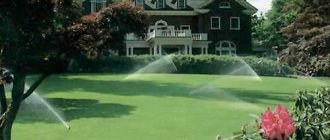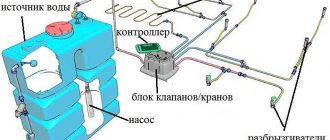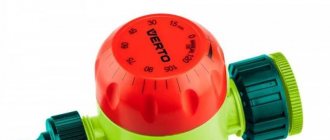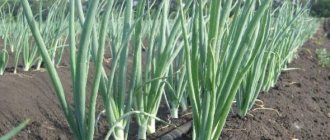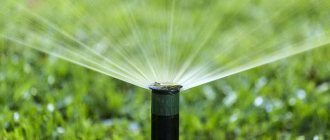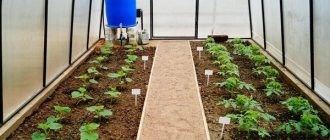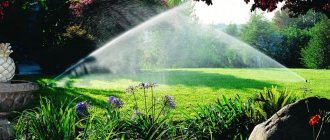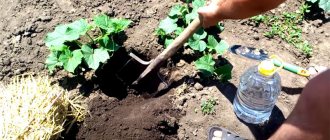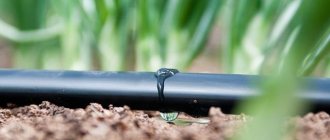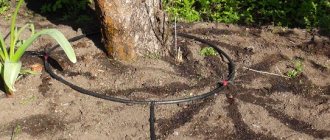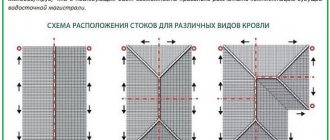Location of the automatic watering system on the site
Each site has its own characteristics. Different plants also require different types of watering. When organizing irrigation at your dacha, you need to take all these points into account, but in general, you can set up an irrigation system on any site. Suitable for flower beds, vegetable gardens and ordinary lawns.
The main thing: you need to organize the system so that water gets evenly to all the right places. Some areas should not be allowed to become overly flooded and others to dry out.
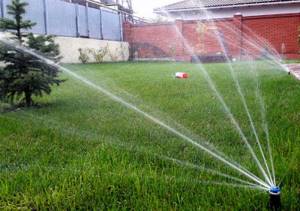
Before starting work on installing the structure, you need to draw a plan of the entire site, mark the buildings and plant locations on it. After installation of the system, control runs are carried out and the irrigation radius is monitored.
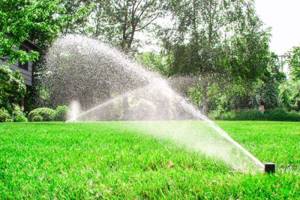
If water does not reach some areas, the arrangement of the elements is changed. This is how the final optimal option for arranging the parts of the irrigation system is selected.
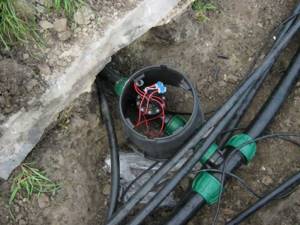
In various photos of automatic irrigation systems, you can see examples of the location of sprayers in the garden.

What types of irrigation systems are there?
The most popular method of watering plants, flower gardens and lawns is sprinkling , that is, when watering occurs from above. Such devices are considered the simplest and easiest to use. They continuously spray a stream of water at a certain angle in one area.
There are also more complex models, for example, rotational ones . In this case, the water hits the ground around the circumference more evenly. Due to such a complex design, the cost of such a unit is much higher than usual.
The principle of operation of the irrigation system is as follows: the hose is connected to the sprayer and the water is turned on. When a stable water pressure is established, the sprinkler begins to function. The operation of such an installation is impossible without a pump. Its performance affects the water pressure. Pumps can be installed either near the well or deep in the ground. Submersible pumps are installed if groundwater is located in the very depths of the soil.
Hedges and some large garden plants require subsurface watering . Drip irrigation is suitable for trees and bushes. The operating principle of this type of irrigation is as follows: water flows through a special design directly to the roots of the plants. It is instantly absorbed, which means that the trees or bushes use all the water. This irrigation system can be used both in the country and in the greenhouse.
The irrigation system is usually used from spring to autumn. The maximum water temperature should not exceed 32 degrees.
There are also manual and automated irrigation . In the first case, the user turns on the solenoid valve and opens the tap. Watering time is independently regulated. The automatic system begins to work according to the specified program. Typically 4 to 6 valves are used simultaneously. Watering times may vary. It all depends on the program and the preferences of the owner.
It is possible to install additional drain valves that operate on batteries. Some summer residents use precipitation and soil moisture sensors and automate the irrigation system, after which it operates autonomously. You can buy such equipment, but it will be cheaper and more economical to make an irrigation system yourself.
Recent Entries
Chainsaw or electric saw - what to choose for the garden? 4 mistakes when growing tomatoes in pots that almost all housewives make Secrets of growing seedlings from the Japanese, who are very sensitive to the soil
Types of automatic watering systems
The irrigation system is chosen depending on what requires irrigation: vegetables in a summer cottage, fruit trees and shrubs, or just a lawn in front of the house.
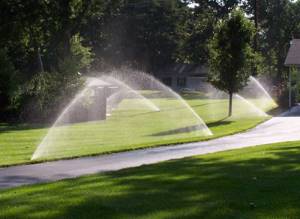
Types of automatic watering systems:
- Sprinkler
- Drip.
- Subsurface irrigation.
Let's consider the features of these systems and their applications.
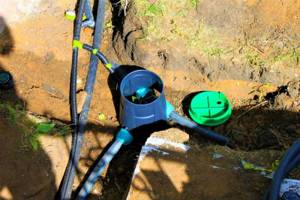
Cost of irrigation systems
If you decide to buy an automatic watering system, then it is worth keeping in mind that, in addition to the design itself, you will also have to pay for installation.
The price of the work depends on the topography of the site, landscape features, irrigation area and personal wishes of the customer. The irrigation structure itself can be purchased for between 2000 and 3000 rubles. For example, a drip installation “ Vodomerka ” costs 2,400 rubles, a system operating on the principle of sprinkling is slightly cheaper - 2,000 rubles. But do not forget that, in addition to these installations, you cannot do without purchasing a pump, hoses, pipes and timers. Therefore, together with the installation, this will cost a tidy sum, so it is much more advisable to make the irrigation system yourself.
Sprinkler system
Sprinkler irrigation is the best option for watering your garden and lawn. Advantages of a sprinkler irrigation system:
- possibility of pressure adjustment;
- harmonious integration of elements into landscape design;
- simultaneous irrigation of soil and plant foliage.
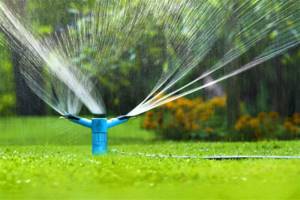
The main component of the system is a sprinkler, also known as a water sprayer.
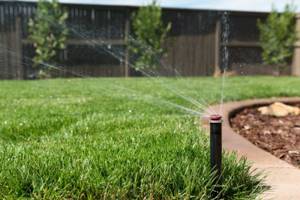
Rotary sprinklers irrigate an area within a radius of up to 30 m. Also, thanks to a moving head, they can change the angle of water supply.
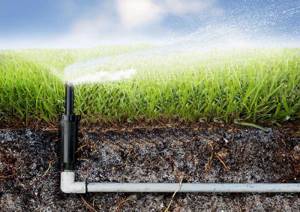
For lawns, retractable sprinklers are produced; they appear above the surface only during operation, and then hide back.
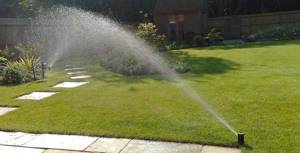
Fan (pulse) sprinklers supply water at regular intervals. They cover an area with a radius of 18 m. Water is supplied in only one direction.
Periodic flooding system
The essence of the periodic flooding method is also quite simple. It consists of filling the plant pot with a nutrient solution from time to time, and then draining the solution back into the reservoir. In this case, the roots of the plants are in the substrate. The frequency and time of flooding are regulated by a special timer. The process looks like this:
- The timer turns on - the pump turns on - the nutrient solution is pumped into the container with the plant.
- The timer turns off and the solution is drained.
This should happen several times a day, depending on the plant and its cycle.
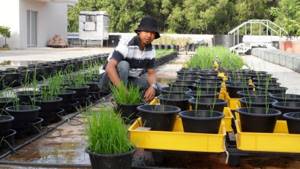
Pros of hydroponic flooding systems:
- Availability;
- Easy to use;
- High plant saturation with nutrients.
Disadvantages of this method:
- The roots may dry out in the event of a power outage;
- Constant monitoring is necessary, otherwise there is a high risk of bacteria and mold.
Drip system
Drip irrigation is used in vegetable gardens and greenhouses. With drip irrigation, only the root zone of plants is moistened, since water is supplied pointwise.
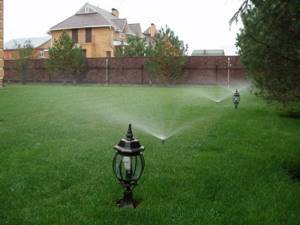
Advantages:
- saving water. The soil is moistened only near the roots;
- water does not get on the leaves. On a sunny day, water on the leaves can cause the plant to burn;
- Possibility of adjusting water pressure.
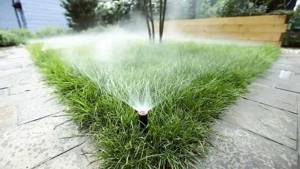
When laying a drip system, the water supply pipe should pass close to the plants - at a distance of 20-40 cm. In relatively narrow beds, one pipe is installed between 2 rows of plants.
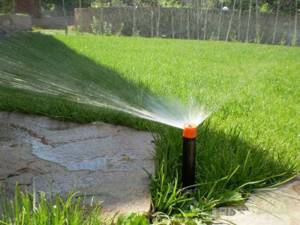
Advantages and disadvantages of irrigation systems
Each irrigation method has its pros and cons. The advantage of an irrigation system based on the sprinkling principle is that this design is very easy to operate. The following steps are sufficient:
- lay a highway;
- unwind the hose;
- can be watered.
In addition, this method is considered “ natural ”, as it imitates rain.
Drip irrigation is considered ideal for plants, since the water does not settle on the leaves, but goes directly to the root system. This method of watering is also better for the summer residents themselves, since in this case the volume of water spent is much less than with sprinkling. Unlike other irrigation methods, the drip system can be used even in full sun. Water gets to the roots without harming the leaves. After all, everyone knows that under no circumstances should you water the leaves of plants in direct sunlight; when the water evaporates, the leaves get severely burned.
In-soil irrigation systems are perfect for capricious plants. However, installing pumps is a rather labor-intensive and costly process.
Subsoil irrigation
When installing such automatic watering, pipes are laid underground and water is supplied directly to the roots. The pipes are dug to a depth of 20-30 cm. This is done simultaneously with planting the plants.
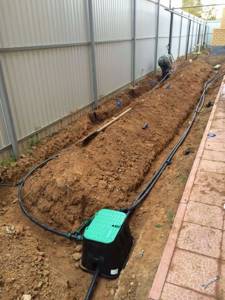
The distance between the two supply pipelines is 40-90 cm, and the distance between the water supply holes located on the pipe is 40 cm.
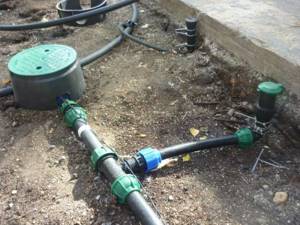
Basically, the subsurface irrigation system is used in greenhouses for growing crops on an industrial scale and in botanical gardens.
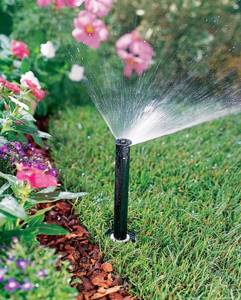
General principles of proper garden watering
- Watering of perennials is carried out in the calculated radius of the soil, in which the bulk of the suction roots are located, while the near-trunk areas with a diameter of 80-100 cm are left untouched.
- Frequent surface watering leads to deformation of the root system of fruit trees, crust formation and deterioration of soil aeration, therefore the intensity of water supply is determined by the nature of the root system of perennial plantings. Watering of a young garden is carried out until the soil is moistened to a depth of 50-70 cm, irrigation of an intensive garden - up to 70-150 cm, depending on the type of fruit trees and the structure of the soil profile.
- Irrigation is not carried out during flowering - this stimulates the formation of the ovary. The first watering begins 10-14 days after flowering, since a prolonged lack of moisture provokes the fall of the ovary.
- The maximum positive effect is achieved by combining methods of local moistening - surface and subsoil drip, sub-canopy sprinkling or aerosol spraying. Sprinkling and drip irrigation are independent types of irrigation that provide a sufficient level of moisture in the soil; aerosol spraying is considered as a means for cooling and humidifying the air, carrying out foliar fertilizing and protective treatments with agrochemicals.
The principle of operation of automatic watering
First, of course, you need a source of water. A pump is connected to it, which will pump water into the system. A liquid distribution unit is connected to the pump.
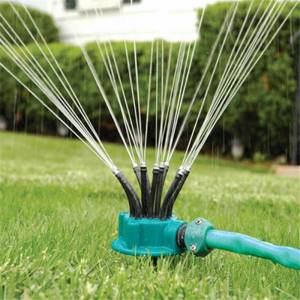
Pipes are connected to the block, through which water is supplied under pressure to the sprayers. Filters are installed at the beginning of the chain so that contaminants that may be in the water do not clog the system.
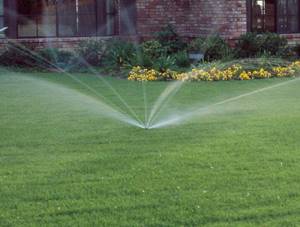
Sensors are also installed, which are responsible for automating the entire process. A programmer is connected to the liquid distribution unit.
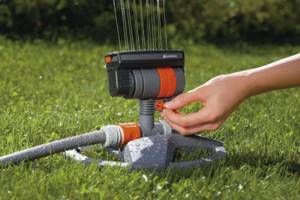
It is this computerized controller that controls the garden watering system. The controller programs the time at which the sensors should open the valves to supply water.
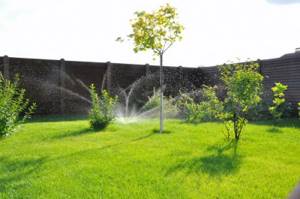
How to make a watering system with your own hands?
Before you start creating an irrigation system, you need to buy the necessary equipment and make a plan. The irrigation scheme is very important, since it is according to it that the amount of materials will be calculated. Also on the diagram you need to indicate the places where the pipeline and hoses will pass. You need to count the number of pipe joints so as not to make a mistake with the number of plugs, connectors and disconnectors. It is better to choose plastic pipes; they are much more practical and durable than metal ones. If there is no main water supply on the site, you need to stock up on a water container, which will be located on a hill. Depending on which irrigation method you choose, you need to mark the hoses, bury them in the ground, hang them, or lay them on the lawn.
Design and installation
Regardless of the choice of automatic irrigation system, it is important to correctly install all its elements.
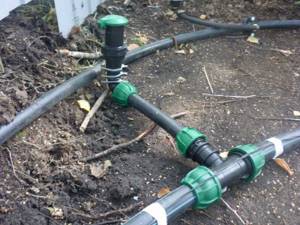
When designing, you need to carefully consider where to place the water sprayers so that you don’t have to manually water forgotten areas later.
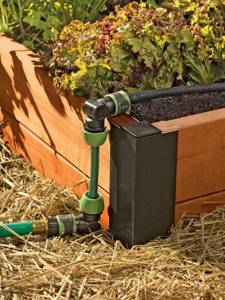
How to water yourself? Let's look at each design stage in detail.
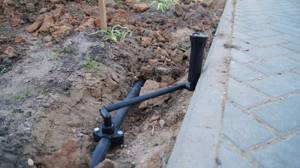
Automatic watering system “Hunter”
Automatic watering Hunter
The Hunter auto-irrigation system is the most famous and best-selling in the global irrigation industry market. Hunter automatic watering is one of the most reliable and convenient; it has the widest range of specialized irrigation equipment. More than 100 types of various professional equipment for automatic watering systems. Thanks to the high quality, reliability, durability and availability of all types of equipment, Hunter products maintain a leading position. All products are developed, tested and manufactured in the USA, which undoubtedly indicates their high quality.
The Hunter automatic watering system is constantly being improved, using new advanced technologies, taking into account modern trends. Quality control is given great importance; automatic watering systems are controlled by several independent experts.
What does the Hunter automatic watering system include:
- high quality, reliable and durable equipment
- fully automated watering process
- automatic synchronization of temperature and solar activity, changing the duration of watering
- Ease of Management
- automatic shutdown of the system during rain, wind or frost
- the ability to choose the optimal watering regime for a certain group of plants (garden, vegetable garden, hedge, lawn, etc.)
- saves your budget - minimum water and electricity costs
- does not require shutdown for the winter
- remote control of irrigation systems
Thanks to the variety of Hunter automatic watering systems, everyone can choose the right option for themselves at an affordable price. He will become your indispensable assistant, completing the tasks assigned to him on time and efficiently. Your “invisible” assistant is installed underground, which facilitates the smooth execution of any gardening work and lawn mowing. Thanks to its “invisibility”, you can now give free rein to your imagination and design a stylish design on your territory without any restrictions. After installing the Hunter automatic watering system, you will forever free yourself from manual watering, you will have a lot of free time and will be provided with proper care of your plants. This means that the Hunter automatic watering system not only takes care of watering your plants, but also saves your free time.
Development of a watering system diagram
In order not to make mistakes during development and not forget anything, you need to draw a site plan. The plan should indicate the source of water, buildings and green spaces.
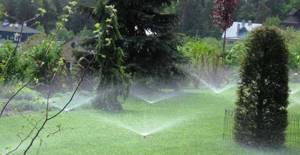
For the plan, choose a scale, for example, 1 meter of plot = 1 cm on the plan. The desired irrigation zones are then marked on the plan.
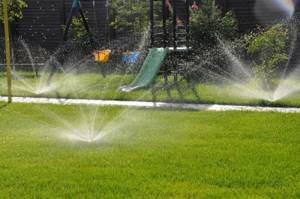
In addition, you need to take into account that tall bushes and trees will retain water, so additional sprinklers are installed to water the plants behind them.

Watering system options
Depending on the type of water supply, the following methods of watering the garden are distinguished:
- surface flooding of the trunk circle or the entire area, creating a maximum supply of moisture (used mainly on soils with low water absorption capacity);
- drip irrigation, in which water is supplied in small doses and gradually absorbed into the ground;
- sprinkling using mechanical or automatic installations that create spray in the form of rain.
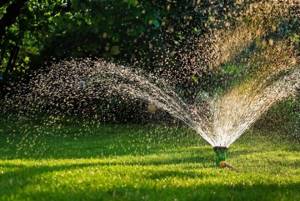
Each of these methods has its own advantages, disadvantages and limitations in use. In this case, surface watering of the garden is carried out using several different methods and can be:
- cupped
- furrowed
- estuary
- pool
Related article:
Spring work on the plot
Drip irrigation, like sprinkler irrigation, is always performed according to the same principle and differs only in the devices for water supply.
Cup
To organize cup watering, first prepare the tree trunk circles, giving them a cup-like shape, and then pour water into them. To do this, perform the work in the following sequence:
- loosen the soil inside the circle, level the surface, forming a low embankment along the edge, which will prevent water from flowing beyond the established limits;
- a distribution channel is laid between the rows and furrows are drawn from it separately to each bowl, ensuring the supply of water individually inside each circle.
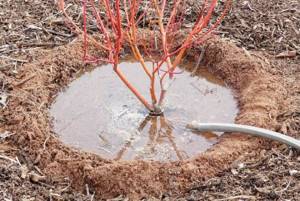
The volume is calculated so that the soil is moistened to a depth of 80 cm.
The advantages of the cup method of watering the garden include the ability to control water consumption. The main disadvantage is that the moistening zone is limited by the size of the bowl, which is why moisture intensively flows to the roots located within its boundaries and does not reach those further away.
Over time, the soil in the tree trunk becomes waterlogged, which leads to two negative consequences:
- the roots that absorb moisture die off;
- the soil structure is destroyed and the surface becomes submerged.
The negative results of cup watering can be partially reduced by regularly loosening the soil in the flood zone.
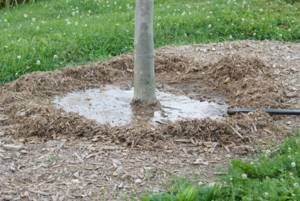
Borozdnaya
Organizing irrigation along furrows laid between the rows ensures uniform moistening of the entire garden area. The location of the furrows is determined depending on the quality of the soil, the planting pattern of garden crops and their individual requirements.
Related article:
How to properly let the soil rest and whether it is necessary to do so: the use of green manure
On average, trench sizes vary within the following limits:
- depth – 15–30 cm;
- width – 40–60 cm.
The length directly depends on the permeability of the soil and the slope of the terrain:
- with high water absorption capacity and slight or no slope - 75–90 m;
- with average moisture absorption and the same slope - 130–180 m;
- with a greater slope – 220–350 m.
The row spacing is adjusted according to the soil composition:
- on light sandy loam – 0.8 m;
- on loamy soils – 1 m;
- on clayey soils - 1.5 m.

Outlet grooves are installed perpendicular to the irrigation furrows, through which water is supplied from the map sprinklers.
The furrow method of garden watering has several advantages:
- ensures uniform moistening of the entire root space;
- minimizes water loss from evaporation, which is typical for other methods of surface flooding;
- the roots that absorb moisture do not die, the structure of the soil is not disturbed, and the surface does not float.
Related article:
How to choose a garden sprayer
To water the garden along the furrows, it is necessary to carry out a set of preparatory work, including preliminary leveling of the area with the elimination of small depressions and hills to achieve greater uniformity of moisture.
Limannaya
The estuary method involves completely flooding the garden. It has many disadvantages, among which are:
- increased water consumption;
- rapid evaporation due to the large surface;
- the rise of water caused by this evaporation from deep soil horizons containing an increased amount of salts harmful to plants.
The greatest harm is caused by the salinity indicated in the last paragraph, which appears most quickly in depressions with prolonged stagnation of water. Therefore, with such a relief, estuary flooding is not used.
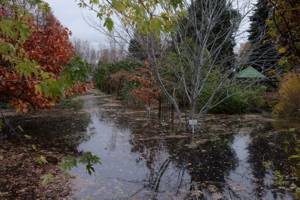
Basseynovaya
Flooding by pools differs from estuary flooding in that it is not carried out continuously over the entire surface, but by dividing the garden into sections. The irrigation organization algorithm should be as follows:
- the territory is divided into squares or rectangles, each of which may contain a certain number of trees depending on the terrain;
- the soil surface inside the pools is leveled, and embankments about 30 cm high are built around the perimeter to prevent water overflow;
- The pools are flooded one by one - from those located above to those located below.
Related article:
Weeding is fun: 5 devices to make work easier that any gardener will love
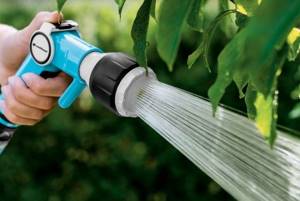
The disadvantages of basin flooding are the same as those of continuous estuary flooding.
Drip
The drip method involves laying thin pipes with a cross-section of no more than 2 cm along the trees, from which separate devices for drip water supply are allocated to each tree. At the same time, the flow rate is approximately 5 drops per minute, so they are immediately absorbed without lingering on the surface. You will also need a large container to which the pipeline is connected.
As an option, you can use small-stream irrigation, for which, instead of pipes and droppers, a hose with holes made in it with a diameter of 4–5 mm with an interval of 80–100 cm is used. The hose is laid in such a way that the water flows under the plantings.
Drip and fine-jet watering options for gardens are the most economical in terms of water consumption, time and effort compared to all other methods. In addition, due to intermittent or gradually continuous water supply, all the negative consequences of surface watering, especially flooding, are eliminated.
Related article:
5 ways to effectively use baking soda in your garden
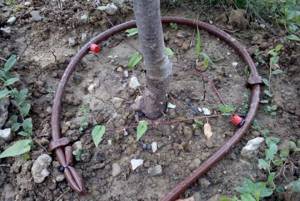
Sprinkling
Sprinkling has all the advantages of drip irrigation, but at the same time it is completely mechanized (or automated) and does not depend on the presence of a slope, without which all other methods are difficult to implement. A significant disadvantage is the increased risk of developing fungal infections, which increases even more with dense plantings.
In addition, if sprinkling is carried out not using a conventional nozzle, which is attached to a hose coming from the water supply, but using an automatic irrigation system, then additional financial investments will be required to purchase it. Also, for automatic irrigation to work effectively, it is necessary to have a stable running water supply and a storage tank with a pump that maintains the required level of pressure.
In any case, sprinklers must be installed correctly:
- at soil level so that they do not interfere with other agrotechnical activities in the garden;
- evenly - to avoid the formation of dry zones.
Related article:
Spring work on the plot
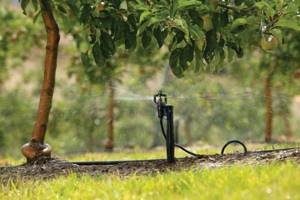
It is also important to provide the possibility of another method of watering in case of breakdown or other unforeseen problems.
Project calculation
A specialist will help you perform all the necessary calculations for an automatic garden watering project. You need to calculate:
- site watering rate;
- volume of water tank;
- pump parameters;
- diameter of main pipes and tubes inside zones.
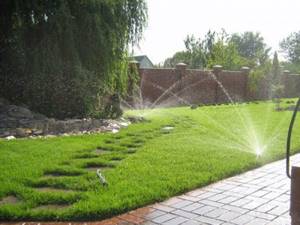
If you have knowledge of hydromechanics, you can carry out the calculations yourself, but it is better to turn to professionals, especially if the territory is large.
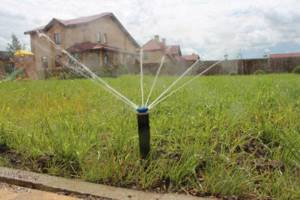
Deadlines and norms
You need to water the garden taking into account the stages of development of the plants planted in it. It is mandatory to introduce moisture:
- after the excess ovary falls off (at the beginning of summer);
- 15–20 days before harvest ripening;
- in the fall after harvest;
- the rest of the time - as needed.
Timely watering within the specified periods contributes not only to increasing productivity, but also to increasing the heat capacity of the soil, due to which the freezing depth in winter is reduced. In this case, it is necessary to take into account the peculiarities of moistening trees and shrubs, as well as the rules for holding an autumn event.
Fruit trees
It is recommended to water fruit trees during the growing season, fruit development and the formation of flower buds for the next year. The trees that most need sufficient moisture are pear, apple and plum trees. Cherries are considered the most undemanding in this regard.
Related article:
What is the best way to deoxidize the soil?
Trees with multi-seeded fruits (pears, apple trees) are watered at the following times:
- in the first ten days of June - after the excess ovules have shed;
- in the second ten days of July - during the period of fruit ripening;
- at the end of summer or early autumn - for all crops during a dry summer, or only for winter varieties if it rains regularly.
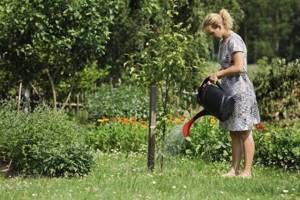
Stone fruits (plums, cherries) are watered according to a slightly different scheme:
- in the third ten days of May or the first ten days of June, when shoots are actively growing;
- 2 weeks before the fruits reach full ripeness to prevent the ovary from dropping;
- after harvesting.
Young trees that have not yet begun to bear fruit are watered as needed. If there is a lack of moisture in the soil due to little snow in the spring, all trees are additionally moistened before the buds open.
The irrigation rate is 50–100 l/1 sq. m depending on the composition of the soil and the age of the plantings. So, on heavy soils the volume is increased to 120 l/1 sq.m. In a young garden - reduce to 80% of the norm to prevent rotting of the root system.
Related article:
Getting ready for the summer holiday season in winter
Berry bushes
Watering and spraying shrubs (raspberries, currants, gooseberries) is extremely important during the formation of buds, flowers and ovaries. The best watering option at this time is sprinkling.
In early spring, watering can harm these crops by causing buds to bloom too early, which can freeze and crumble in the event of return frosts. For the same reason, it is not advisable to moisten shrub plantings too late in the fall.
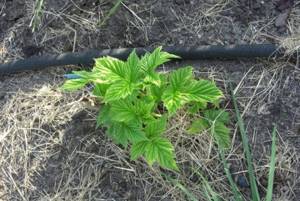
Water volumes depend on the crop and soil composition. Per 1 sq. m the norm varies within the following limits:
- for gooseberries – 10–20 l;
- for raspberries – 20–35 l;
- for currants – 30–45 l.
During autumn watering, which is carried out during leaf fall, water consumption is doubled.
Selection of sprinklers
For individual planting areas in low parts of the site, drip irrigation is the best choice. But the lines for rain and drip irrigation must be separate. Different types of sprayers cannot be installed on the same line.
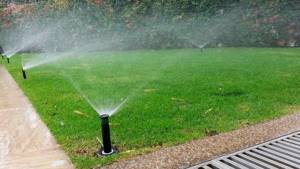
Different types of sprayers require different system pressures, so you won't be able to adjust the pressure in such an uneven line.
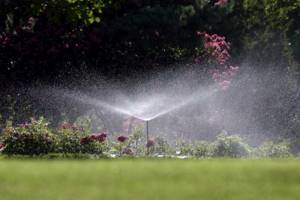
Features of irrigation systems
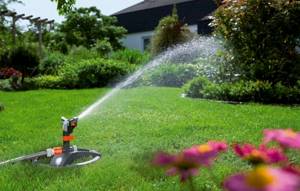
Irrigation system (IS) – different complexes that irrigate the required area. Used for the following areas: parks, flower beds/lawns, greenhouses, vegetable gardens, home garden areas. Selected in accordance with the capabilities of the pump and water source. As a rule, devices are used from spring to autumn.
The work of the joint venture occurs in the following sequence. First, connect the hose to the sprayer, then turn on the water. After establishing a stable pressure, the structure begins to function. The performance of the irrigation system directly depends on the pump. It is installed in two ways - directly near the well/water supply and deep in the ground. The latter option is suitable when groundwater is located in the depths of the soil.
Water intake systems also play an important role in the operation of watering devices. These can be large tanks or pumps that take water from the water supply. The first option is considered more economical, since rainwater can be collected into the tanks. The second one is more convenient because the devices do not take up much space.
All irrigation systems are divided into 3 types:
- Automatic watering (SAP) - all processes are carried out in automatic mode (on/off according to a set schedule, adjustment of all watering cycles, programmed mode).
- Manual systems - turned on/off by the user by supplying water. To activate, you must turn on the solenoid valve and open the tap. Irrigation time is set and adjusted independently.
- Mixed - one part of the system is under the control of the user, the other is under the control of the controller.
The advantages of watering complexes include the following:
- uniform irrigation of the territory;
- simple, effortless operation;
- economical water consumption due to dosed supply;
- communications are placed underground at a depth of about 40 cm (for subsoil);
- remote control (for SAP);
- possibility of independent regulation.
Necessary materials
If you are knowledgeable about plumbing and electrical installations, you can install automatic irrigation yourself. The following materials and equipment will be required:
- pump;
- programmable controller;
- wires and corrugated pipe to protect them;
- plastic pipes;
- fittings, tees, valves;
- sprinklers (sprayers).
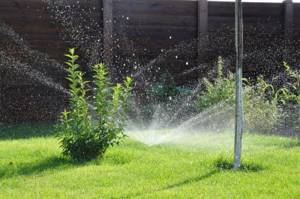
The installation of pipes is carried out in accordance with the lines that were drawn on the plan.
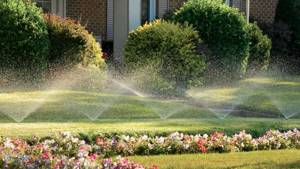
Professional fittings IRRITEC
IRRITEC fittings
Professional fittings IRRITEC (Italy) – used for connecting plastic pipes. The company is one of the world's leading brands of plastic fittings manufacturers. Its products are trusted by a huge number of customers all over the world. And for good reason. IRRITEC continuously introduces new technologies, improves the qualifications of its employees, and conducts research to improve its products. The company also greatly values the opinions of its customers. Research, surveys, questionnaires, observation and analysis are constantly carried out. IRRITEC professional clamp or compression fittings are often used when installing automatic irrigation systems and when installing pumping stations. The high quality standards of professional IRRITEC fittings, ease of installation (when installing IRRITEC fittings there is no need to remove the clamping ring), and the reliability of the connection are recognized all over the world. Clamp fittings have been developed for high pressure water supply, potable water supply as well as hot water supply. IRRITEC professional fittings meet the highest international standards. Thanks to the use of reliable materials, IRRITEC fittings last a long time even after the warranty period. Many customers prefer IRRITEC due to its ease of installation. Each person can easily install the necessary part into their automatic watering system without special equipment.
Pipe laying
Pipes are laid on the ground or underground. The option of laying on the ground is a summer option for watering the garden plot. This structure is dismantled for the winter.
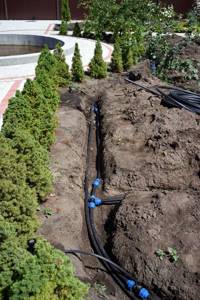
When installing a permanent automatic irrigation system, a trench with a depth of 30 cm is dug to lay the pipeline.
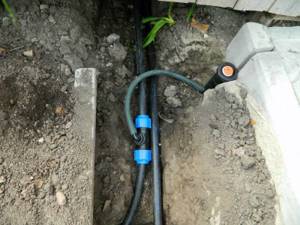
For the main center line, choose a larger diameter pipe. Thinner pipes are connected to it. They use polymer pipes that are not susceptible to rust. Before burying the pipeline, a working test is carried out.

It is also necessary to install a valve to reduce pressure; it will be needed to drain water when preparing the line for winter. The valve is installed in the drainage well.
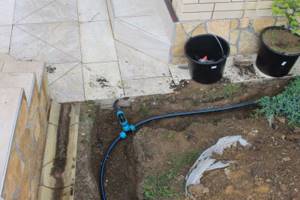
To save water, install a sensor that detects soil moisture. During rain, such a sensor will block the start of irrigation.
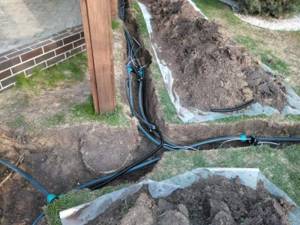
What is an automatic watering system and why is it needed?
An automatic watering system is a modern solution for replacing a watering can or hose in any area. It can be installed in a country house, in a cottage, on the territory of an enterprise, and even in a park. What are the main advantages of an automatic irrigation system compared to manual irrigation?
Main advantages
First, you don't have to waste time manually watering. Secondly, it is impossible to manually achieve the same result as with organized automatic watering. Thirdly, the system works even when you are not on site. Fourth, there are various sensors that monitor the weather and soil moisture. Fifth, sprinkling occurs when it is needed. Sixth, the system is not visible on the site until it is working; all elements are underground at a depth of 25 - 30 cm. And seventh, the system uses water and electricity with high efficiency.
What to water and how it happens
There are 3 main types of irrigation:
- Sprinkler irrigation is used to water lawns, shrubs, trees and flower beds with unpretentious plants. How it works: a watering element is installed on the lawn - called a sprinkler with a special attachment - a nozzle. During irrigation, the rod rises under water pressure to a height of 5, 10, 15 or 30 cm, depending on the sprinkler model, and watering occurs through the nozzle. Trees are watered without spraying water, water simply pours from the sprinkler and moistens the soil around the tree.
- The second type of irrigation is drip irrigation. Drip irrigation is used for watering flower beds of any type, be it roses or dandelions. They are also used for watering flower beds, shrubs, hedges or vegetable gardens and greenhouses. How it works: drip irrigation is a special tube with holes that is placed on the ground without digging. The holes are located along the entire length of the tube every 33 cm. During watering, water oozes out of these tubes. Not suitable for lawn watering. It will lie in plain sight in the grass and make it inconvenient to mow the lawn.
- Microdrip irrigation. Used where simple drip irrigation is not enough or where more precise distribution of water is needed. For example, in greenhouses, agricultural complexes and winter gardens.
Installation of connecting elements
Polymer pipes are fastened together with compression fittings. It is at the connections that leaks can appear over time. Therefore, all tees and taps are mounted in hatches for ease of access.
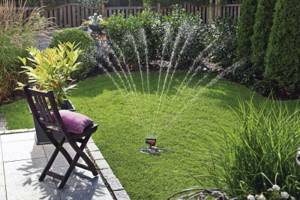
General rules
To effectively water the garden using any of these methods, you must follow a number of general rules:
- to determine the need for moisture, dig up a little soil at a depth of 30 cm and squeeze it in the palm of your hand - as long as it sticks together into a lump, watering is not required, as soon as it begins to crumble, it is necessary to water;
- in any case, the upper soil horizon should not be allowed to dry out completely;
- moistening should be infrequent and not too abundant, since when the surface layer in the soil becomes waterlogged, air exchange processes are disrupted;
- the optimal depth of soil moisture in the root zone for trees is 0.8–1 m, for shrubs – 0.5–0.6 m;
- you should not over-flood the area near the trunk, since the large lignified roots growing here do not have absorbing ability;
- water must be supplied to the projection area of the crown perimeter and beyond, where small roots are located (the more fertile the soil, the closer to the trunk the absorbent roots are located);
- In order for the soil to be as water-absorbing as possible, it must be dug up regularly, otherwise a certain amount of water will not be absorbed, but will remain on the surface and evaporate;
- Each time after complete absorption of moisture, the surface must also be loosened to avoid the formation of a crust.
Related article:
Weeding is fun: 5 devices to make work easier that any gardener will love
Air humidity should also be taken into account. In dry, hot weather, moisturizing is required more often than in damp and foggy weather.
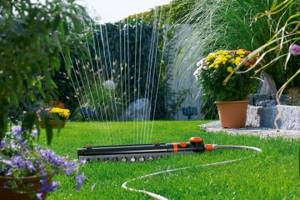
Winter protection
To prevent the automatic irrigation system from deteriorating when frost sets in, the water from it is completely drained before the onset of real cold weather. To do this, use a pressure reduction valve.

All threaded connections that are above the ground are disconnected and stored for the winter. If you do not want to dismantle the sprayers and drippers for the winter, then the system must be purged after draining the water.
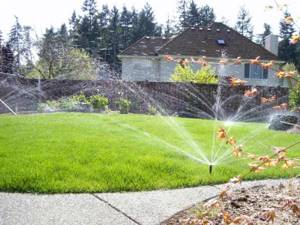
Purge operating pressure up to 6 bar. By completing these measures, you can be sure that when spring comes, your automatic watering system will be in working order.
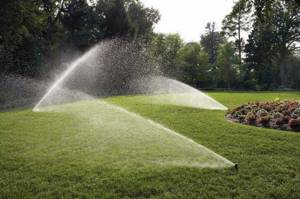
The cost of installing an automatic irrigation system will pay for itself by saving water and your time. Automatic watering is targeted and adjusted according to the desired schedule. Such a garden watering system will allow you to free up a lot of time for other activities and just relaxation.
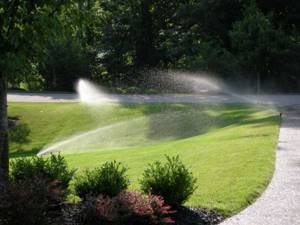
Automatic watering system “Rain Bird”
Automatic watering system “Rain Bird”
One of the win-win options is the Rain Bird automatic watering system (USA). For more than 70 years, the company has been producing Rain Bird self-watering systems, the quality of which has been tested over the years. Modern Rain Bird products comply with European standards ISO 9001. Rain Bird is the founder of automatic watering systems. The main and priority area of activity of the company is the development of Rain Bird automatic watering systems. Great emphasis is placed on using water wisely. Rain Bird is renowned for its innovation. Their development of the impact sprinkler was awarded a historical plaque by the American Society of Agricultural Systems Engineers in 1990. Today the company provides a choice of more than 4,000 irrigation devices. With such a large selection of products, you can customize auto-irrigation for all types of irrigation, from agricultural work to the football field. Rain Bird's self-watering system is used at such famous venues as the soccer pitches at Estadio Bernabeu in Madrid and Rome's Olympic Stadium, as well as some of the world's best golf courses, including Pine Valley Golf Course and Pebble Beach Golf Links.
What does the Rain Bird automatic watering system include:
- Rain Curtain technology
- irrigation control using wireless controllers (battery powered)
- irrigation control via computer using wireless terminals and central controllers
- the ability to organize an irrigation schedule for various zones and areas, indicating the intensity for each area
- ease of installation
- minimal water and electricity costs
- Thanks to filters, it allows hard and dirty water to pass through, bringing its condition to an optimal level.
The Rain Bird automatic watering system can remain under a layer of damp soil for several decades without being subject to corrosion and maintaining its quality characteristics. The entire installation is located at least 20 cm deep into the ground, which allows you to carry out any garden work without interference. Irrigation water passes through purification filters, clearing mechanical debris. If the soil or air becomes too dry, watering will begin, since the SAP weather station constantly monitors weather data. If it's raining or cloudy outside, the smart Rain Bird system won't waste water. The automatic watering system is equipped with sensors that open the electric valve only when the plants really need watering. Thanks to its simple installation, excellent performance and ease of use, it is ideal for use in private landscaped areas, public lands and commercial areas. The Rain Bird company guarantees the reliability of its automatic watering systems, noting its special durability and resistance to many external factors.
Control units and sensors in automatic watering systems
The next most important components of automatic irrigation systems are control units and sensors. The latter can measure the amount of precipitation, humidity, soil and air temperature, adjusting the operation of the control unit. The control unit, in turn, can be programmed for various modes throughout the year, carry out several waterings during the day, and also change the program depending on weather and climatic conditions.
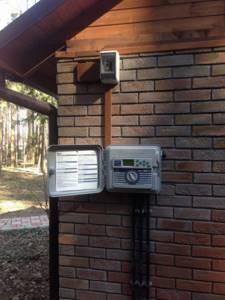
Water pressure in the automatic watering system
As a rule, the pressure in public water supplies is not suitable for operating automatic irrigation systems. Therefore, to supply water, pressure boosting stations or separate storage tanks are used, fed through filtration units and supplied by powerful pumps.
Will automatic watering withstand hard water in the Moscow region?
In the case of feeding automatic irrigation systems with artesian water, in the Moscow region, a big problem is the high content of iron salts, which leads to rapid failure of sprinkler mechanisms. Therefore, even at the design stage of an automatic watering system, it is advisable to provide water deferrization systems. Also, for normal operation of sprinklers, mechanical filtration of water is necessary.
Designing, installing, programming and maintaining an irrigation system is a rather complex matter, which is much safer to entrust to professionals than to later eliminate the consequences of unskilled work. It is very important that you understand that the specialists designing your irrigation system must understand not only the hardware, but first of all, the plants they are going to water. We hope that the materials in this article will allow you to evaluate the professionalism of potential contractors.

Types of watering systems for the garden
- Without the use of automation.
- Semi-automatic.
- Automatic.
Loading…
Irrigation without the use of automation
A popular, but low-effective and labor-intensive method. This method gives results only in small areas: small flower beds, 2-3 short beds, small greenhouses. This is done using a regular watering can or a portable hose connected to a water source (tank, tap).
Flaws:
- a crust forms on the soil;
- there is a high probability of formation of “burns” on plants due to moisture residues;
- uneven distribution of moisture.
Advice! This irrigation is best done in the early morning hours or in the evening, before sunset.
Semi-automatic watering system for vegetable garden
Characterized by the ability to regulate pressure, turn on and off the water supply. To do this, a pipeline of small cross-section is deepened into the soil and connected to a tap using flexible adapters, and sprinklers are brought to the surface:
- sectoral;
- circular;
- pendulum;
- pulsed.
Another type of semi-automatic watering system for the garden is drip irrigation. It is a plastic flexible pipe with valves covering small holes. When pressure appears and increases in the irrigation system, the valves open, allowing liquid to exit the pipeline.
Automated irrigation
It is being implemented in the same way as a semi-automatic system with small but important additions that greatly facilitate the gardener’s work:
- electronic control of watering time and intensity;
- depending on the conditions, the liquid is pumped using a submersible or surface pump;
- built-in sensors that determine soil dryness (sensor), etc.
Irrigation methods
- Drip - with this type of irrigation system for the garden, water is supplied directly to the root system of the plant through small holes in hoses dug into the soil.
- Sprinkling - plants are irrigated from above using a hose or pipe with a sprayer; when pressure appears, drops or fine water spray begins to spray.
- Intrasoil - as a rule, this method is used in large garden plots and vegetable gardens, while hoses, polypropylene or metal pipes are deepened into the soil, according to a certain pattern, horizontally, through which water is subsequently supplied.
- Surface is the most common method, most often watering is carried out in strips, furrows or between ridges, less often - selective or continuous flooding.
Types of irrigation systems
There are several ways to water your garden:
- sprinkler;
- drip;
- intrasoil;
- moisture recharging.
Let's look at each of them in detail.
Sprinkler irrigation system

There can be two sprinkler methods:
- air;
- above ground, with pipe laying.
Air irrigation is convenient and easy to install. It has special spray nozzles, which are mounted in the pipe at equal distances.
Water from small cracks in the pipe forms small drops and provides micro-irrigation watering of the garden.
The disadvantages of aerial rainwater irrigation include the fact that the water must be purified and the pressure must be at least 2 atm.
Water from a well, lake or other open source will not work, so if you want to use this type of water, install a filter at the entrance to the system.
In a above-ground garden irrigation system, the quality of the source does not matter.
To create such irrigation, you can use a regular plastic pipe and install it to a depth of at least 80 cm.
Nozzles are installed in the pipe in a checkerboard pattern, which will spray water.
Above-ground and air irrigation are similar in that they both require pressure. If it is not enough, then use a pump.
The disadvantage of such irrigation may be the problem of replacing pipes if they leak or break. To do this, you will need to rip out the entire wiring system.
These methods are excellent for polycarbonate greenhouses.
Drip irrigation system
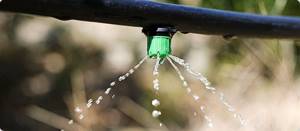
Such irrigation is carried out by supplying water to the roots of plants. You can arrange it so that water flows deep into the earth (using droppers) and onto the surface of the earth (using a drip tape or hose).
By type they distinguish:
- gravitational;
- forced.
Gravity watering of the garden is carried out by supplying water under the influence of gravity and pre-filling the container, while forced watering works from a water supply connected to a well.
To create pressure in the gravity irrigation system of the garden, the container is raised to a height of 2 meters.
During drip irrigation, water comes into the container from a water supply system and a main pipe with branches.
Branches can be made using fittings, and the main pipe must be laid along the garden or in a furrow or along the greenhouse.
Drip irrigation branches are connected to drip lines along the entire length of the bed. For drip lines, you can use drip tape with holes or a pipe with droppers.
Drip lines are closed with flush taps and plugs.
In order to avoid clogging, install a filter, valve tap and reducer at the junction with the water supply.
Subsoil irrigation system for garden
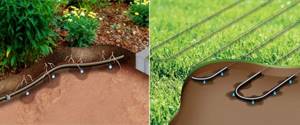
This type of irrigation is similar to sprinkler irrigation, because the pipes are also located underground, but it differs in that there are no nozzles on the surface of the earth.
Watering the garden occurs inside the soil, when water seeps through specialized pipes and hoses with pores.
These are not plastic pipes and cost a little more, but this has the advantage of saving water.
Subsurface irrigation does not irrigate a large area, but it all depends on the diameter of the pores in the hose and the characteristics of the soil (how well it absorbs moisture).
If you want to install subsurface irrigation in your garden over a large area, then lay pipes more often and make a pipeline with the greatest number of branches.
This irrigation system is perfect for greenhouses and vegetable gardens, and will also appeal to rose bushes.
Moisture-charging irrigation system

There is no point in relying on rain in this climate, so artificial irrigation will help you keep your garden and plants fruitful.
A lack of water in the autumn, when the soil and fruits are preparing for winter, can lead to poor yields, and this is deplorable for any gardener.
Moisture-recharging irrigation will be a real salvation in this case, it will help:
- will help the autumn growth of the root system;
- keep the soil warm;
- will help not dry out the soil in winter.
Water-recharging irrigation is not suitable for apricot, cherry plum, plum and other stone fruit trees. Rather, it will be harmful to them. Also, you should not use it on clay soils, low areas, or places with high groundwater. In this case, site drainage will be required.
It is better to install a moisture-recharging irrigation system in September, even if it rains at that time.
It is better to water the garden and vegetable garden using a hose. To find out the required watering time, place the hose in a bucket and note how long it takes to fill it.
Then estimate how long it will take for the required amount of water to be absorbed into the ground.
Watering systems for the garden
Each system has pros and cons, and they are not suitable for all plants. So, first things first.
For example, sprinkler systems are used to water lawns and shrubs. They are not suitable for flower beds because the petals can deteriorate from moisture. It is also not used for watering potatoes, tomatoes and other plants that are affected by diseases associated with high humidity (in particular, late blight). And all unpretentious crops love sprinkling.
Drip irrigation is ideal for plants, but far from the best from a garden design point of view. Numerous hoses do not decorate the site at all. They have to either be hidden under dense foliage (for example, in a flower garden under hosta leaves), or used only in the garden area.
Subsurface irrigation requires installation costs because pipes (or hoses) must be buried in the ground. Typically, such irrigation is used in industrial-scale gardens.
